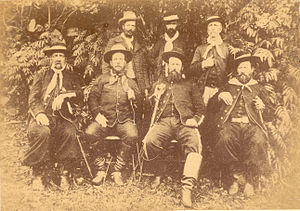
Back Revolució Federalista Catalan Revolución federalista riograndense Spanish Révolution fédéraliste French Federalistische Revolutie Dutch Revolução Federalista Portuguese Федералистская революция Russian
This article needs additional citations for verification. (May 2021) |
| Federalist Revolution | |||||||
|---|---|---|---|---|---|---|---|
 Gumercindo Saraiva and maragato commanders | |||||||
| |||||||
| Belligerents | |||||||
|
| |||||||
| Commanders and leaders | |||||||
| Strength | |||||||
| 22,000 soldiers and militia |
7,500 federalist rebels ~500 rebel sailors | ||||||
| Casualties and losses | |||||||
| approx. 10,000 dead | |||||||
The Federalist Revolution (Portuguese: Revolução Federalista) was a civil war that took place in southern Brazil between 1893 and 1895, fought by the federalists, opponents of Rio Grande do Sul state president,[a] Júlio de Castilhos, seeking greater autonomy for the state, decentralization of power by the newly installed First Brazilian Republic.[1]
Inspired by the monarchist ideologies of Gaspar da Silveira Martins, who had been one of the most prominent politicians by the end of the monarchy and acted as political head of the revolution, the federalists had Gumercindo Saraiva as the military head supported by his brother Aparicio Saraiva, of the Uruguayan National Party, and by the Navy rebels who, after being defeated at the capital following the Rio de Janeiro Affair, moved south to strengthen the federalist forces. Also known as maragatos, the federalists fought the republican forces of the Brazilian Army headed by the Rio Grande do Sul senator and army general Pinheiro Machado.
The conflict was not limited to Rio Grande do Sul, affecting the entire southern region of the country, which was mostly under federalist control.[2] The rebels' objective was to group the forces against the republican government of Floriano Peixoto and march to the capital, Rio de Janeiro, to depose him.[3][4][5] The federalists effectively installed a parallel government by deposing the presidents of the states they controlled and holding elections[6] and by adhering to the proclamation by the navy rebels of Prince Pedro de Alcântara as emperor Pedro III.[6][7] Nonetheless, after the Siege of Lapa, the federalists were unable to advance further, being defeated in the Battle of Campo Osório. The end of the war consolidated the young Brazilian republic, leaving 10,000 dead, many of which were beheaded.[8]
Cite error: There are <ref group=lower-alpha> tags or {{efn}} templates on this page, but the references will not show without a {{reflist|group=lower-alpha}} template or {{notelist}} template (see the help page).
- ^ Miriam Ilza Santana (15 October 2007). "Revolução Federalista" (in Portuguese). InfoEscola. Retrieved 25 September 2012.
- ^ Walter Fernando Piazza (1983). Santa Catarina: sua história (in Portuguese). Federal University of Santa Catarina. p. 508.
- ^ "Revolução Federalista". POLÍCIA MILITAR DO PARANÁ (in Portuguese). Archived from the original on 2 June 2021. Retrieved 22 August 2020.
- ^ "Revolução Federalista" (in Portuguese). InfoEscola. Retrieved 12 April 2019.
- ^ "Folha de S.Paulo - Fovest - 08/05/2003". www1.folha.uol.com.br. Retrieved 25 August 2020.
- ^ a b Bueno, Eduardo (2003). Brasil: uma História (in Portuguese) (1st ed.). São Paulo: Ática.
- ^ Pierre Petit (21 July 1894). "The Uneasy South America". The Graphic. Retrieved 14 February 2021.
- ^ Alzira Alves de Abreu. "Revolução Federalista". Fundação Getúlio Vargas (in Portuguese). Retrieved 24 March 2021.